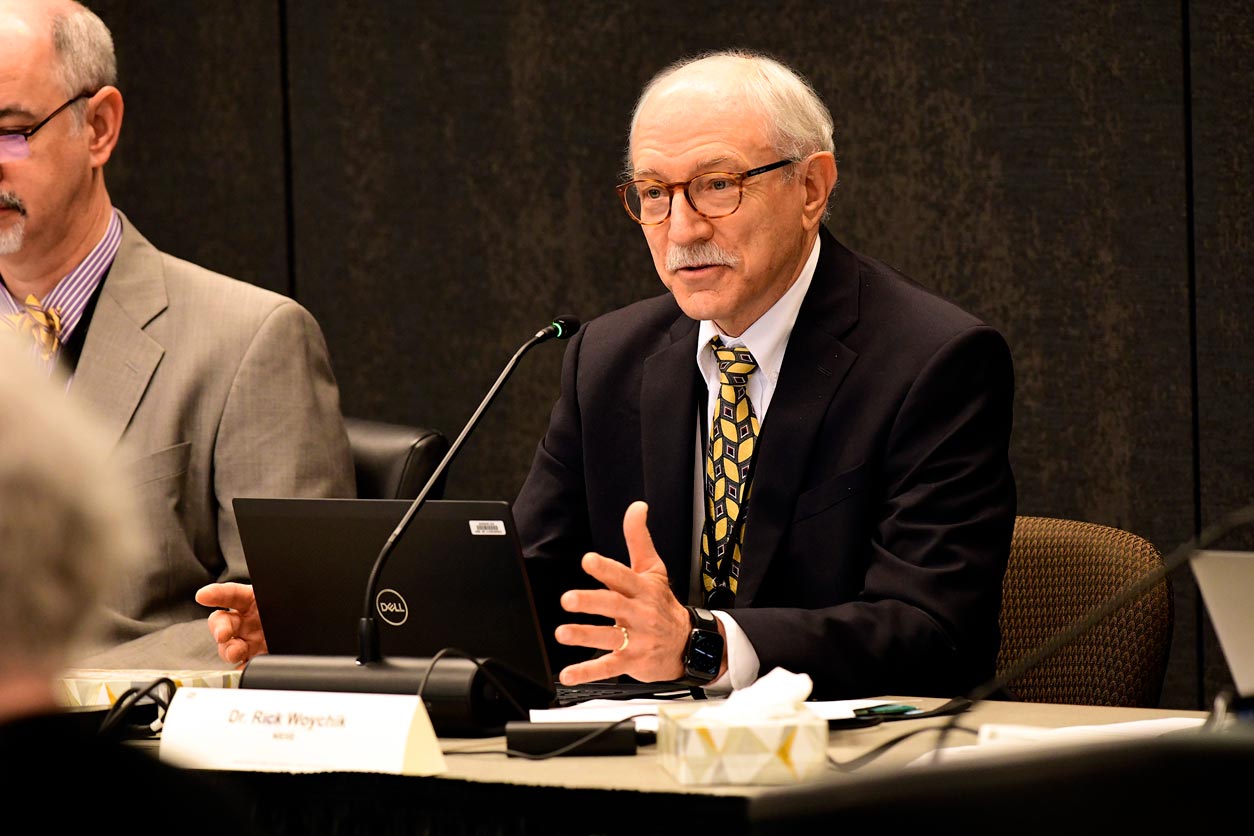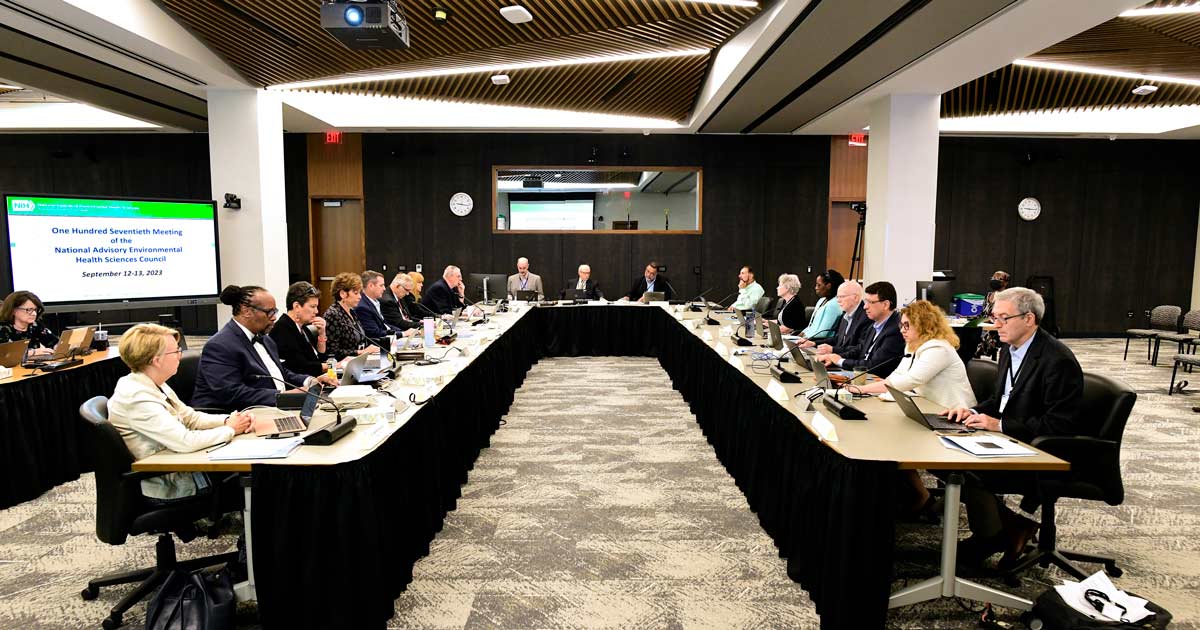From artificial intelligence (AI) and machine learning to new cross-institute collaborations and funding concepts, NIEHS is continually seeking a deeper understanding of precisely how the environment affects our health. These and other topics were presented at the National Advisory Environmental Health Sciences Council (NAEHSC) meeting Sept. 12-13.
Developing AI tools for precision environmental health
AI is the future of environmental health sciences, according to several experts who presented on the topic of AI’s applicability to capturing exposome attributes and assessing human health data from electronic health records. The exposome is a term used to describe the totality of an individual’s exposures throughout life and the body’s response to them.
- Thomas Hartung, M.D., Ph.D., from Johns Hopkins Bloomberg School of Public Health, said AI is producing multimodal programs to assist with the retrieval and integration of billions of toxicology-related data points across chemicals, chemical mixtures, animal replacement models, and more. He said AI is the answer to information-flooding and can help us find our way through all of the information available. Hartung also suggested agencies highlight the FAIR Data Principles and commit to full data transparency and public accessibility to data.
- Machine learning and AI expert Marzyeh Ghassemi, Ph.D., from the Massachusetts Institute of Technology, expressed agreement for the need for more data sharing and transparency, particularly for improvement of machine learning processes. Ghassemi warned about biases in clinical AI and demonstrated several examples of such during her presentation, titled “The Pulse of Ethical Machine Learning in Health.” She explained how note-taking processes and even imaging technology can contribute to biases in diagnoses because machine learning and AI can only be as accurate as the information fed into the systems.
- Michael Snyder, Ph.D., a Stanford University genetics professor who also serves on the NIEHS Personalized Environment and Genes Study (PEGS) external advisory committee, demonstrated the Exposometer, an environmental sampling unit an individual can wear to monitor environmental exposures. The meter can be used in conjunction with electronic health records to develop better diagnostic indicators, assess seasonal patterns of exposures, and capture chemical exposure composition for precision environmental health.
- A socioeconomic and exposome risk score for chronic obstructive pulmonary disease was explained by Chirag Patel, Ph.D., from Harvard Medical School Department of Biomedical Informatics, during his presentation “Multi-Modal AI to Interrogate the Complex Exposome in Complex Traits.”
David Balshaw, Ph.D., director of the Division of Extramural Research and Training, initiated an open Council discussion following the day’s presentations.
“What could be done and what should be done?” he asked Council members. “This is a field that is moving extraordinarily quickly. How can we achieve programmatic development within this space and keep up with the pace of such technologies?”
“We have to learn how to learn faster,” said Council member Gary Miller, Ph.D.
Linking the environment and health with precision
Linking environmental data with health outcomes to develop precision environmental health would help enhance the roadmap to precision medicine, according to Josh Denny, M.D., chief executive officer of the National Institutes of Health’s All of Us Research Program, who presented a talk to Council members titled “Using Environmental Factors to Shape Precision Medicine.”
Denny discussed the environment’s role in health and disease, and explained how All of Us plans to quantify gene-by-environment interactions among its participants. For example, more than 398,000 participants have donated their electronic health records and more than 500,000 have shared a biospecimen with the program (i.e., blood, saliva, urine). This summer, the program distributed 30,000 Fitbit devices and continued talks to partner with NIEHS on ways to better understand environmental exposures and health.
All of Us soon will announce an award to develop a new Center for Linkage and Acquisition of Data.
“We are a fragmented health system, and this could help fill in some of the gaps,” Denny said, regarding the usefulness of electronic health records to the promotion of precision environmental health.
An evolving concept

Fred Tyson, Ph.D., Genes, Environment, and Health Branch program director, presented a new EPitranscriptomics CrOsstalks and Toxicants (EPCOT) concept to the Council. Exploring the effects of environmental exposures at the cellular level offers NIEHS an opportunity to influence the evolution of the epitranscriptomics field, Tyson said. Epitranscriptomics is the study of how RNA transcripts are chemically modified to regulate multiple cellular processes, including gene expression.
“Our understanding of epigenetics will be incomplete without the study of transcriptomics,” said Council member and concept reviewer Gokhan Mutlu, M.D. “If we don’t understand the RNA modifications, what we know about DNA modifications and histone modifications will not be sufficient in terms of our general understanding regarding how the environment affects our epigenome.”
“This is a novel area that is completely understudied,” added Council member and concept reviewer Karen Vasquez, Ph.D.
The next NAEHSC meeting will be held Feb. 12-13, 2024.
(Jennifer Harker, Ph.D., is a technical writer-editor in the NIEHS Office of Communications and Public Liaison.)
Source link
factor.niehs.nih.gov

